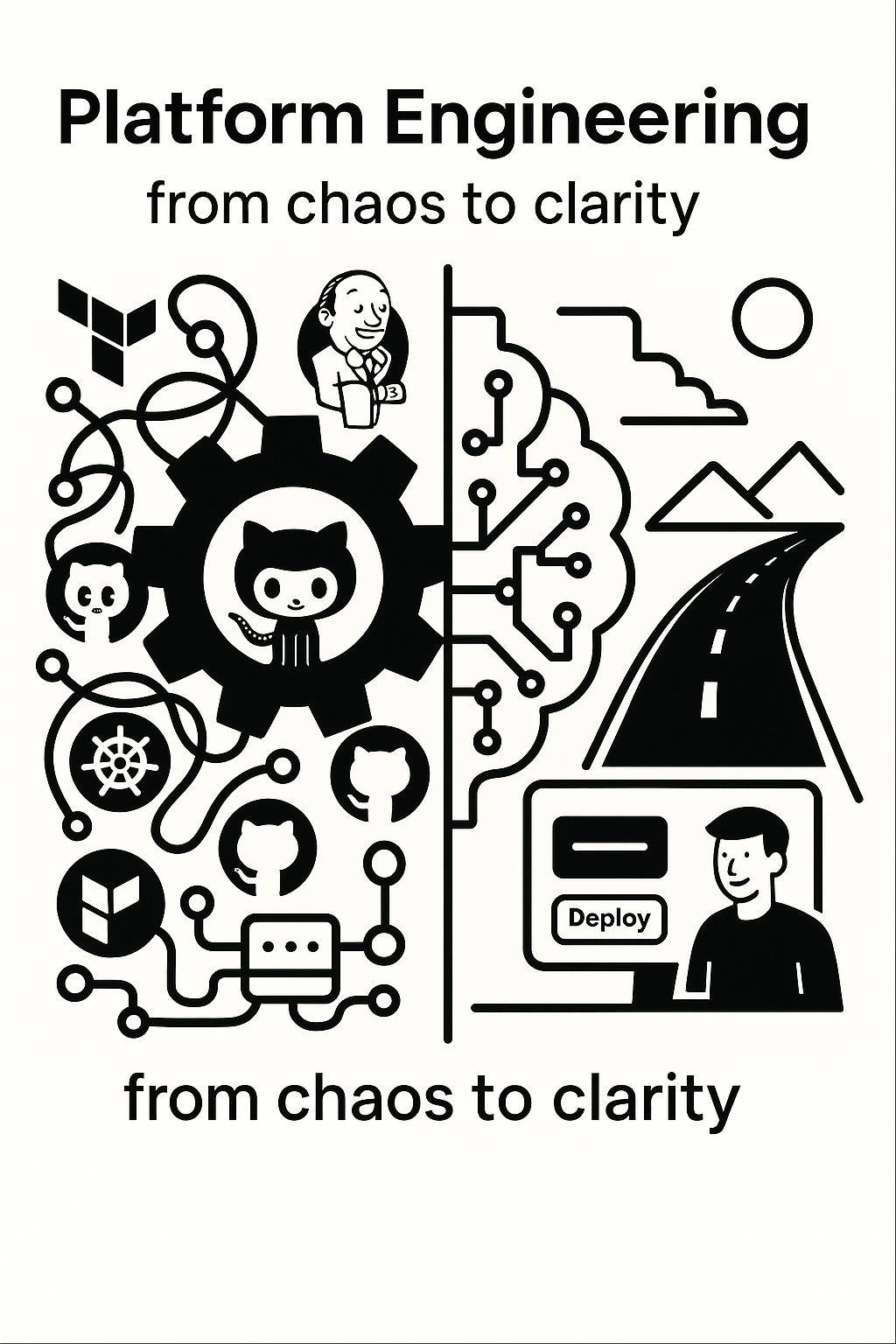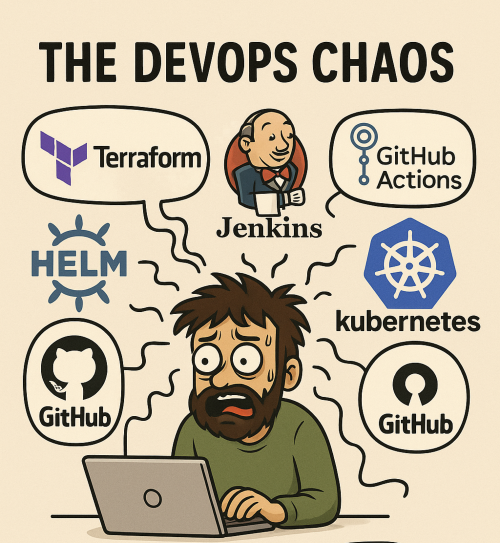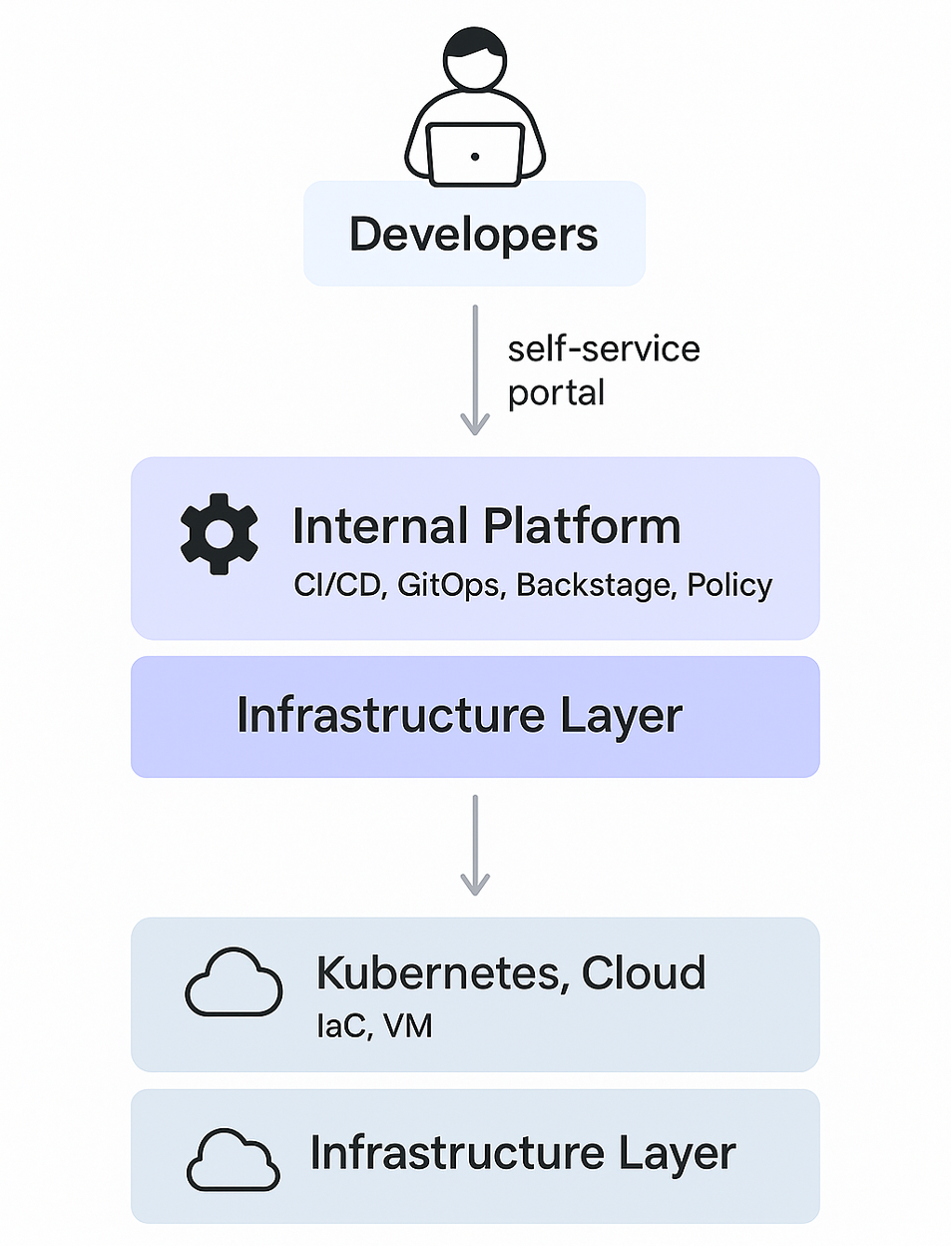Platform Engineering: The Answer to DevOps’ Self-Inflicted Chaos


There was a time when “doing DevOps” seemed to solve everything.
You’d automate a couple of pipelines, a few Terraform scripts, two Helm charts—and boom: continuous delivery, happy teams, satisfied business.
Then things changed.
Applications multiplied. Clusters grew into hundreds. Tools… too many to count.
Every new service required mastering half an encyclopedia of configurations, YAML files, and secrets scattered across clouds and Git repos.
Developers started asking: When can I get back to writing code instead of fighting infrastructure?
And so, gradually, Platform Engineering was born.

When Complexity Becomes a Cultural Bug
For years, we confused automation with simplification.
We automated everything—CI/CD, provisioning, policies, monitoring—but never made it easier to use.
We built perfect machines, but impossible to drive.
Platform Engineering emerged from this realization:
it doesn’t automate for its own sake, but for the people who use it.
Its goal isn’t just to deploy an app, but to create a smooth experience for the person deploying it.
In other words: it builds a highway, not a shortcut.

The Core of the Discipline: The Platform as a Product
Imagine a company with ten development teams.
Each one has its own pipeline, its own Terraform templates, a different Helm version—and no one knows where the logs end up.
Every new service means reinventing the wheel.
The Platform Engineering team steps in to break that cycle.
It builds an internal platform that provides:
- standardized environments (VMs, Kubernetes, or cloud),
- integrated delivery tools (CI/CD, GitOps, ArgoCD, Backstage),
- centralized visibility and security.
Developers no longer need to know infrastructure details:
they pick a service template, hit “Deploy,” and the system handles the rest.
The result? Fewer errors, less wasted time, and—above all—less cognitive load, the true enemy of productivity.

DevOps, SRE, and Platform Engineering: Who Does What?
These roles are often confused, but the distinction is subtle and crucial:
| Role | Focus | Customer |
|---|---|---|
| DevOps | Application delivery | End user |
| SRE | Reliability and performance | End user |
| Platform Engineer | Creation and management of internal platforms | Technical teams |
The Platform Engineer works upstream: building the foundations that let DevOps and SRE move faster and with less friction.

Skills of a Modern Platform Engineer
It’s a hybrid role where technical depth meets product thinking.
A good Platform Engineer masters:
- Kubernetes (EKS, AKS, GKE, Kubeadm);
- Infrastructure as Code (Terraform, Pulumi, Crossplane),
- CI/CD & GitOps (GitHub Actions, ArgoCD, Jenkins, Tekton),
- Major cloud providers (AWS, Azure, GCP),
- Observability & Security (Grafana, Prometheus, OpenTelemetry, RBAC),
- Programming (Go, Python, or advanced scripting).
But what truly sets them apart isn’t the toolset—it’s the product mindset.
A Platform Engineer treats internal developers as customers and asks daily:
“Am I really making their lives easier?”

Platform Engineering and Artificial Intelligence: A Natural Match
The arrival of AI in pipelines and platforms is pushing Platform Engineering into a new evolution.
Platforms no longer just create environments and automate deployments; they’re becoming intelligent ecosystems that learn, optimize, and prevent problems.
Some concrete directions where these worlds meet:
- Predictive automation: AI models can anticipate build failures, cluster congestion, or CI/CD bottlenecks.
- Cost optimization: AI can analyze cloud usage patterns and suggest or apply dynamic scaling to reduce waste.
- AI-assisted DevEx: by integrating chatbots and copilots in the self-service portal, developers can request environments, configure pipelines, or debug issues using natural language.
- Integrated MLOps: Platform Engineers are now building unified platforms that support Dev, App, and AI workflows in a single, cohesive experience.
In short, AI is making platforms more aware—capable not just of automation, but of learning from what they automate.
The future of Platform Engineering lies in building platforms that not only serve developers but collaborate with them.

A Real-World Example (You Might Have Lived It)
A SaaS company had over 30 microservices in production.
Each new service required two weeks to get a complete CI/CD environment.
After months of frustration, they created a dedicated Platform Engineering team.
They chose Kubernetes as the foundation, standardized pipelines with GitHub Actions, and introduced Backstage as a self-service portal.
Within a few months, provisioning times dropped from days to just a few hours.
Development teams no longer need to open tickets to “create a cluster” or “add a secret” — everything is managed through an interface or API.
The biggest change? Developers went back to focusing on what they love most: writing code that creates value.
When Does Platform Engineering Make Sense?
You don’t need to start right away.
If you’re a five-person startup, a dedicated team might be overkill.
But once you start seeing signs like:
- inconsistent environments,
- release delays,
- recurring Ops requests,
- duplicated or undocumented tooling,
…it’s time to think platform-first.
Not for fashion—but for technical survival.

Caveats & Considerations
Before jumping into building an internal platform, it’s worth keeping in mind a number of risks and critical aspects. Here are the main ones:
Excessive internal complexity
The platform itself can become a “ministry of complexity,” shifting the cognitive load from development teams to the platform team.
Tip: Start with a few core services (an MVP), keep the architecture modular, and avoid over-engineering.
Low adoption
If developers don’t perceive real value, they’ll tend to bypass or ignore the platform.
Tip: Involve users from the very beginning, collect real feedback, and maintain a high degree of flexibility.
High initial cost and effort
Building and maintaining a platform takes time, resources, and governance.
Tip: Start small, measure ROI early, and scale only what truly works.
Rigidity vs. freedom
A platform that’s too rigid can stifle team innovation and creativity.
Tip: Implement guardrails instead of hard restrictions, and allow controlled overrides when needed.
Tool sprawl
Too many overlapping or redundant tools can create conflicts, technical debt, and maintenance headaches.
Tip: Rationalize your toolset, plan periodic reviews, and maintain a clear, shared roadmap.
Slower deployments
Introducing extra steps (policies, approvals, manual workflows) can add latency.
Tip: Automate wherever possible, measure “time to change,” and remove bottlenecks continuously.
Updates and compatibility
Platform evolution can break existing services or introduce regressions.
Tip: Adopt semantic versioning, stable contracts, and reliable rollback strategies.
Security and compliance
Poorly centralized systems can become a single point of failure for security.
Tip: Integrate DevSecOps from the start and balance centralized controls with local autonomy.
Lack of culture or skills
Without the right culture or skill set, the Platform Engineering team may never take off.
Tip: Invest in training, mentoring, and build a culture of collaboration and continuous feedback.
The “initial gain, then regression” effect
Many initiatives show early improvements but then stagnate when evolution slows down.
Tip: Keep iterating, monitor key metrics, and act quickly when performance starts to decline.
Conclusion: The Real Automation Is Empathy
Platform Engineering isn’t just a set of tools—it’s a mindset shift.
It puts people—engineers—at the center, building experiences that are smooth, predictable, and safe.
Reducing complexity doesn’t mean simplifying the system; it means making the experience of using it simple.
And that’s exactly what makes Platform Engineering the next natural evolution of DevOps.


